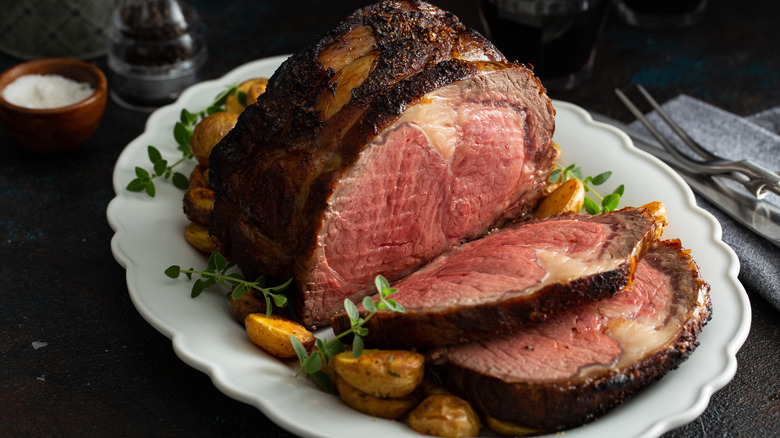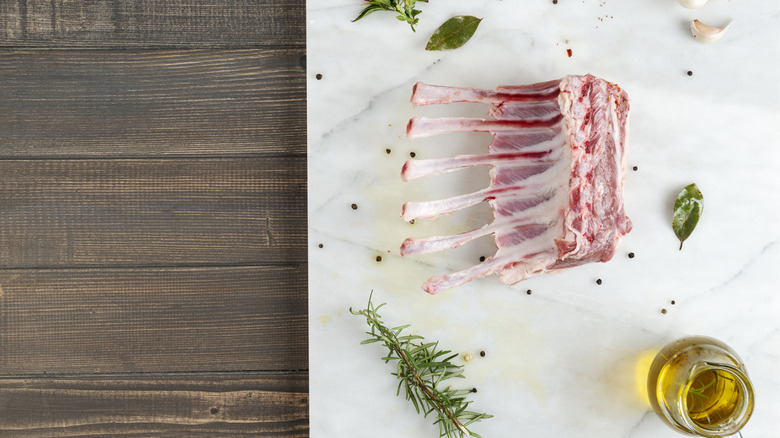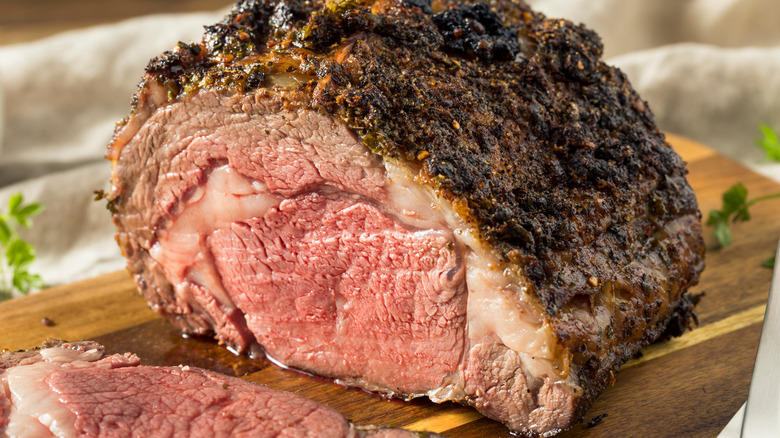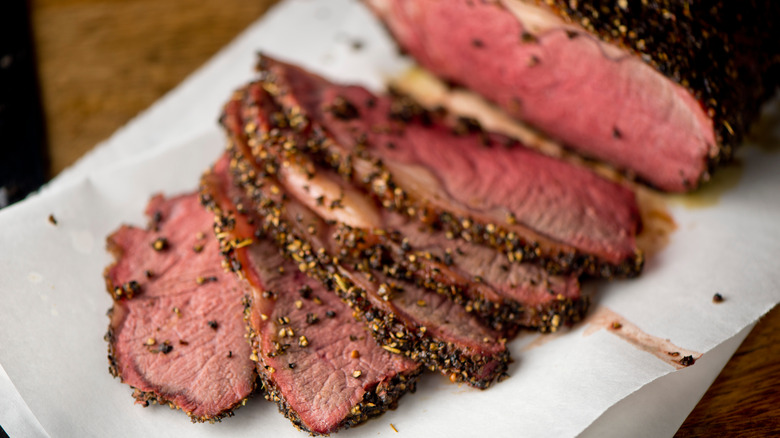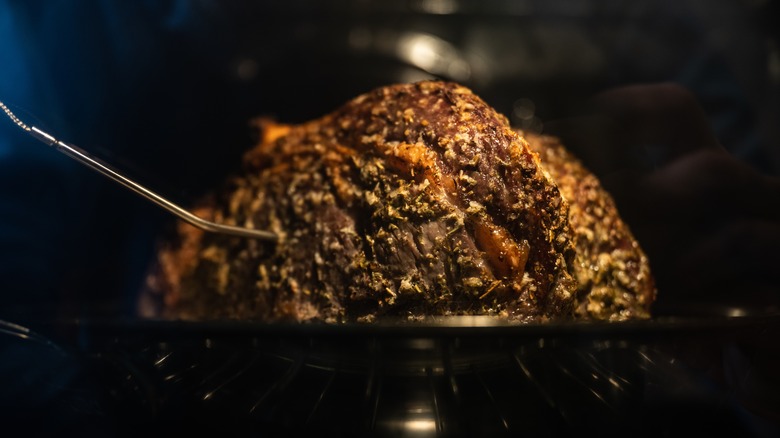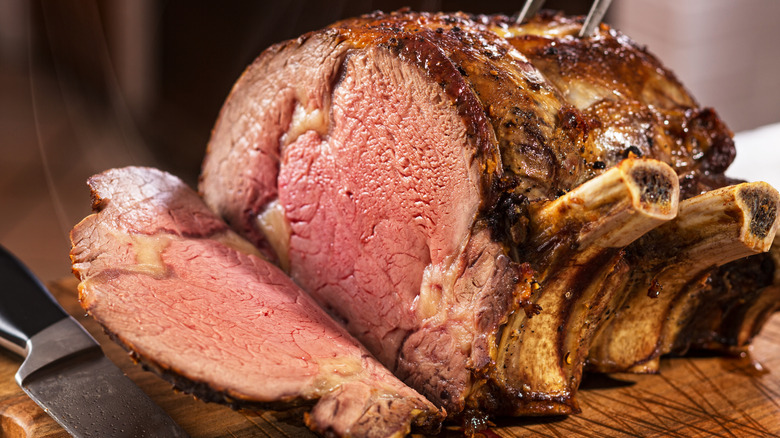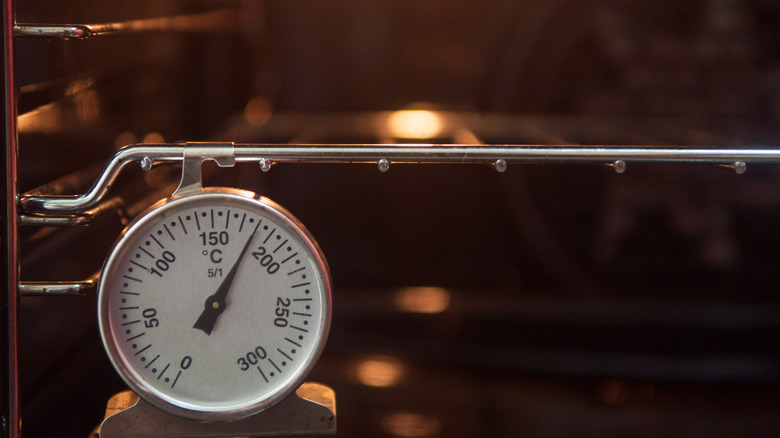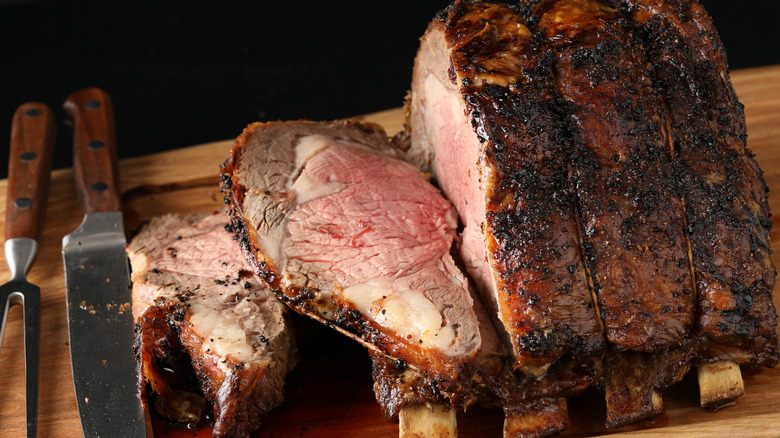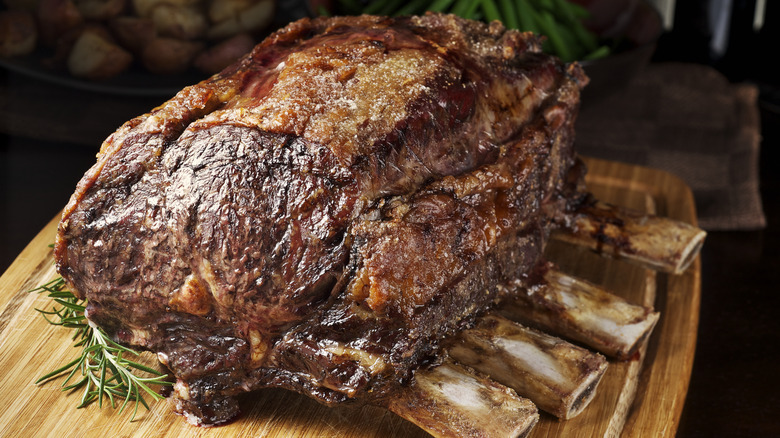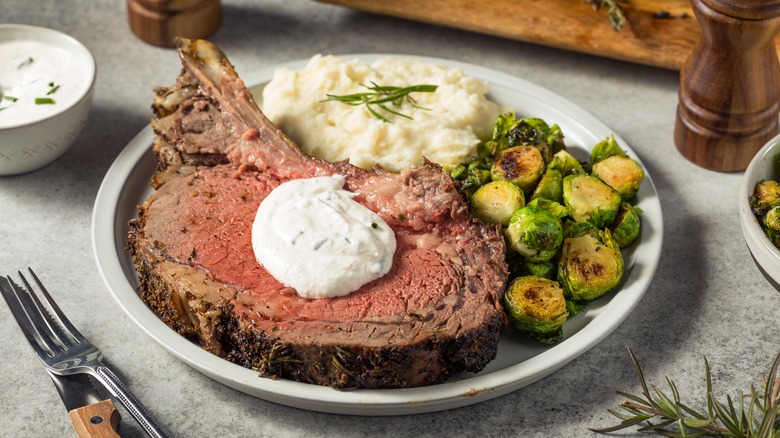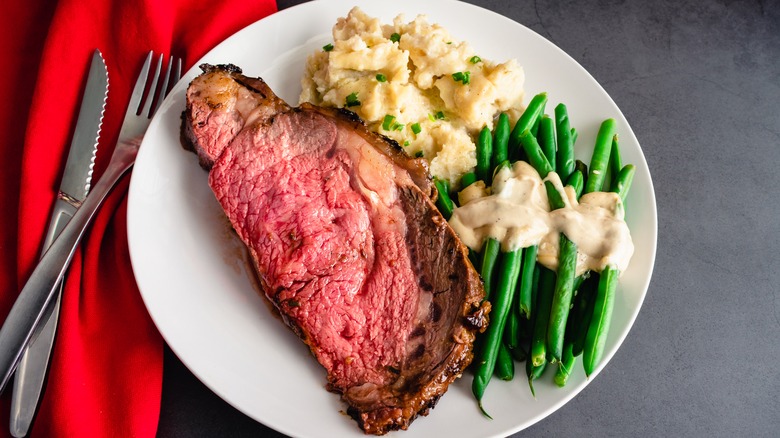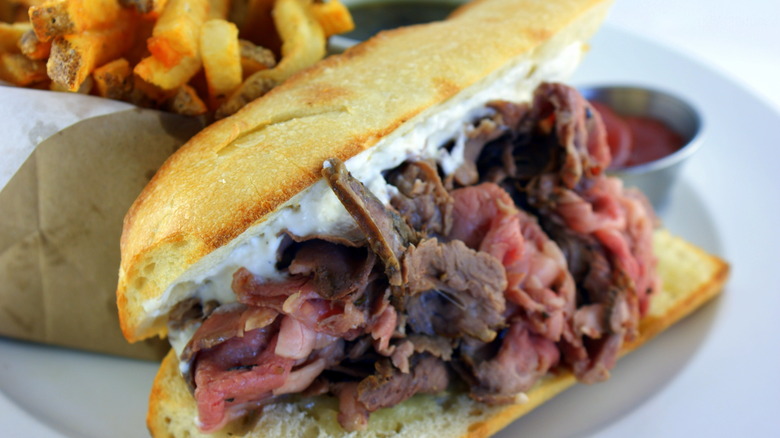12 Mistakes Everyone Makes Cooking Prime Rib And How To Avoid Them
We may receive a commission on purchases made from links.
Prime rib is hands down one of the best cuts of meat, and it makes an elegant meal. This high-quality cut is from the beef rib primal and can be roasted bone in or out. The name prime rib may be confusing because of the word prime, also the name of one of the three classifications that the USDA gives to meat, based on the amount of fat and age of the cattle. But not all prime rib is classified as Prime. To add to the confusion, prime rib is sometimes referred to as a standing roast or a rib eye roast, but while the names are often used interchangeably, the price tag can help you determine if it is prime rib with the Prime classification because a quality prime rib is expensive. A standing roast is the same cut but not as high in quality, making it more affordable.
If you are looking for a meal to celebrate a special occasion or make an unforgettable family feast, prime rib is your answer. This expensive cut of meat can be intimidating to even experienced home cooks, though, and the high price tag means you don't want to make any mistakes that will ruin the roast. Luckily, we have gathered the best advice online about preparing and cooking prime rib, so you can learn the mistakes that are all too easy to make, and how to avoid them.
1. Not carefully selecting the prime rib
The first mistake people make is not knowing how to choose the best prime rib. While you can buy this cut at the grocery store, you should ideally visit a butcher or buy it online for the best beef. Prime rib is a special meal, and you shouldn't look for a discount because you may end up with an inferior cut. Instead, look for a prime rib that's classified as Prime, if your budget allows. If not, a cut classified as Choice is a good option.
The fat or marbling in the meat is a key part of any prime rib because more fat equals more flavor. The meat should have a nice amount of marbling, but not so much that it's more fat than meat. The next thing to consider is whether you want a bone-in or boneless cut. Most experts recommend a bone-in cut because it helps the meat cook evenly, but chef Isaac Toups recommends home cooks opt for cooking boneless prime rib to avoid difficulty removing the bone and to make slicing and presentation easier. One way to get the flavor without the hassle of removing the bone yourself is to ask your butcher to remove the bone and tie it back together. When considering what size of prime ribe you'll need, a good rule of thumb is one pound of meat per adult and about half a pound per child.
2. Only roasting and not trying other methods
The classic way to cook a prime rib is by searing it to seal in the juices and then roasting it, while some prefer the reverse searing method, roasting first and searing at the end. But roasting isn't the only way to cook a thick cut of prime rib. The grill and smoker are great options, too.
The grill may be intimidating if you aren't used to grilling such a large cut of meat. The trick to grilling prime rib is to keep it low and slow, turning it every thirty minutes so the meat cooks evenly. The Grill Masters Club recommends tying the meat with butcher twine because the awkward shape of the meat makes it challenging to flip over. For a smoky flavor, they suggest placing wood chips on a sheet of aluminum. Chef Bobby Flay grills his prime rib between 300 and 325 degrees Fahrenheit, bone side down, until it has an internal temperature of 125 degrees.
Smoking prime rib is another excellent way to cook this cut. You can use hickory, apple, mesquite, or your favorite wood. Some experts suggest dry brining before smoking, to infuse the cut with flavor. Chef Billy Parisi recommends smoking at 225 degrees Fahrenheit for two and a half to three hours for best results. However you cook your prime rib, there is one general rule that professional chefs all follow: Prime rib should be cooked medium rare for the best texture and flavor.
3. Skimping on seasonings
Salt and pepper are just the start of the seasoning that makes a great prime rib; spice rubs, dry brines, and marinades are all good choices too. Chef Bobby Flay seasons his prime rib with small cuts filled with garlic cloves. As the roast cooks, the garlic softens and blends into the meat for fantastic flavor. Lawry's prime rib from the well-known Chicago restaurant relies only on Lawrys's seasoning salt to enhance the meat's natural flavor. Chef Alton Brown keeps it simple with sage and red wine to season his prime rib, while Chef Anne Burrell gives her prime rib a kick with cayenne, rosemary, and garlic. As you can see, there's no one right way to season a prime rib — this is the part where you can have fun and get creative with your seasonings and spices.
However, there is some debate as to when to season a prime rib. Some recommend seasoning the night before so the meat can soak up the flavors. Others just season it an hour before cooking. Either way, make sure to season your prime rib well.
4. Cooking it from cold
One of the golden rules of cooking a prime rib is not cooking it cold. When you buy your tasty hunk of meat, chances are good that you aren't cooking it at that moment and are instead keeping it in the refrigerator until it's time to start preparing it. The important point to remember here is to remove it and let it come to room temperature so it can cook evenly. This can take some time, so plan ahead and remove the prime rib from the refrigerator two hours before cooking. If you're concerned about food safety and having the meat on the counter for that long, the USDA explains that foods are safe for two hours on the counter between 40 and 140 degrees Fahrenheit, so two hours is a safe amount of time for bringing the prime rib to room temperature.
Another common mistake with cooking prime rib is not preheating the oven; it is essential to preheat your oven for thirty minutes before roasting. The oven needs time to heat up in order to cook properly, so make sure to always start with a hot oven and room-temperature meat.
5. Overcooking
One of the worst things you can do to this quality cut of beef is to overcook it. Prime rib is best when it's cooked low and slow for optimal flavor. Experts recommend roasting boneless prime rib at 350 degrees Fahrenheit for 15 minutes or 325 degrees Fahrenheit for bone-in prime rib. If you try to cook it at a higher temperature, the meat will dry out and overcook. As a general rule, it's better to undercook than overcook. With undercooked meat, you can always put it back in the oven to finish it off.
If you make the mistake of overcooking your prime rib, there isn't a way to turn back time and undo what's been done. But you can pivot your menu and try to salvage the meal by turning it into something new. You can shred overcooked meat and throw it in the crock pot with beef broth and cook it for a few more hours to soften it up. It won't be as delicious as slabs of prime rib, but you can salvage it into something tasty like a Mexican birria or stew.
6. Using the wrong type of thermometer
The right tool for the right job is the kitchen motto every home cook should follow, and for cooking prime rib, one essential tool is a meat thermometer. Not any meat thermometer will do, either. Experts recommend using an instant-read thermometer rather than a leave-in thermometer. The reason is that leave-in thermometers aren't as accurate as instant-read.
Apart from having the right thermometer, you need to know how to use it. The best way to get the internal temperature of the prime rib is to insert it in the middle of the roast at the thickest part. Ideally, check the temperature when it's a couple of minutes before the finished cooking time. Some home cooks get anxious about temperature and use the thermometer too many times, repeatedly opening the oven door to poke unnecessary holes in their prime rib. So use a good instant-read thermometer and only check the temperature once — and keep the oven closed so you aren't losing heat, which will affect the overall cooking time.
7. Taking it out of the oven too soon or too late
The timing of when you take the prime rib out of the oven is just as important as how long it was in there. When food comes out of the hot oven, whether prime rib or brownies, it continues to cook. The internal temperature takes time to heat up and also takes time to cool down. If you have ever accidentally made brownies that turned out rock-hard, you might already be familiar with this.
One tip from Dave Rose, the Executive Chef for Omaha Steaks, for cooking the perfect prime rib is to take it out five degrees before the desired doneness. For medium rare, the prime rib should be 125 degrees Fahrenheit, so it should be removed from the oven when the internal temperature is 120 degrees, then covered with foil to trap the heat and left to rest on the counter. It will continue to cook even though it is out of the oven, and within 15 or 20 minutes, it should be medium rare. He also recommends not cooking the prime rib to more than medium for the best results.
8. Forgetting to let it rest
Not giving your prime rib a chance to rest is an easy mistake to make. After all the preparation and cooking time, hungry home cooks and their guests are ready to dive into that perfectly cooked prime rib, and many make the mistake of cutting it right away. Instead, you need to have some restraint and patience to let it rest before carving it into steaks. The resting time depends on the size of your prime rib, but in general, according to chef Thomas Keller, the cut should rest for half an hour. The process of resting the meat helps seal in the juices. If you cut right away, those juices just run out and leave the meat dry.
After the roast has rested, it's time to carve it. You'll need a sharp carving knife to start, then carve the meat against the grain. If you don't carve the meat against the grain, it can be too tough and chewy to enjoy, and all of your hard work will have been for nothing.
9. Serving without sauces
Traditionalists may tell you that prime rib only needs to be served au jus or with the meat's natural juices. While it is good that way, this doesn't mean you can't have your own take on how to serve prime rib. Chef Bobby Flay stays mostly traditional but takes his au jus up a notch by adding thyme. And while the classic roast has enough flavor and texture to keep it simple, there are a few sauces perfect for prime rib. You don't have to slather it on each piece, but you should make sure you have some sauces on hand to serve with your deliciously juicy prime rib steaks.
One of the classic sauces is horseradish. This is ideal with prime rib, but the store-bought jars of it can be a little too intense for some people. You might try making a milder horseradish sauce yourself, that keeps that tangy flavor but won't make your eyes water. Blue cheese sauce is another excellent option to serve with prime rib. It's creamy with a mildly sharp taste, perfect for savory meats. Alternatively, you can serve it with an Argentinian chimichurri sauce. This is a mix of fresh parsley, garlic, and red wine, which pairs well with beef.
10. Ignoring the sides
The prime rib is the star of the show, but it isn't the entire show. Side dishes and salads will help to round out the meal. You can keep it traditional and serve the classic sides that usually accompany prime rib, like mashed potatoes or baked potatoes, creamed spinach, and green beans. At the same time, you shouldn't be afraid to buck tradition and try new sides — your guests might just find a new favorite.
When planning the sides to serve, consider your guests' dietary restrictions. Obviously, you won't be hosting a prime rib dinner for your vegan and vegetarian friends, but consider making some dairy-free or gluten-free sides. It doesn't have to be complicated; think smashed baby red potatoes or steamed spinach with bacon. Or get creative with dishes like garlic mushrooms, roasted butternut squash, or a winter green salad with walnuts, pomegranate seeds, and blue cheese. You want your sides to be just as good as the main dish.
11. Reheating leftovers in the microwave
After your excellent prime rib dinner, don't be surprised if you have a lot of leftovers. Prime rib is a large cut of meat, and you may have over-calculated how much each guest would eat, or maybe you bought extra to have leftovers. The first thing to do is to determine if you'll be able to use those leftovers within a few days. Leftover cooked beef keeps for 3-4 days in the fridge but can last for 2-6 months in the freezer, so freezing may be your best option if you'll be out of town or don't think you can get through the leftovers in time.
When ready to use that frozen prime rib, place it in the refrigerator for four days to thaw it. Do not make the mistake of thinking you can just throw that perfectly cooked leftover prime rib in the microwave. Chef Dave Rose is firmly against reheating prime rib in the microwave. He suggests using a hot cast iron pan to sear the leftover steaks, or using the oven on low, around 225 degrees Fahrenheit, to heat them up slowly without overcooking them.
12. Not getting creative with leftovers
One of the best things about making a big dinner is all that time in the kitchen gets you more than one meal — you get leftovers, too. You can either enjoy those leftover prime rib steaks as they are, or turn that leftover meat into a whole new dish. French dip sandwiches with toasted bread are an obvious choice. Or you could take a cue from Carmy and make some Italian beef sandwiches à la The Bear. Just sauté some onions and peppers for added texture, and layer on some Swiss or provolone cheese to hold the whole shebang together.
Sandwiches aren't the only way to use up those leftovers, however — you can also turn them into a hearty chili or stew. Perhaps pair the meat with pasta and make an Italian bolognese or a Russian beef stroganoff. Take those leftovers south of the border and make steak tacos or tostadas. Leftover beef mixed with rice and beans is the perfect burrito filling. Or throw some chunks on a pile of chips with jalapenos and cheese for some super leftover prime rib nachos.
